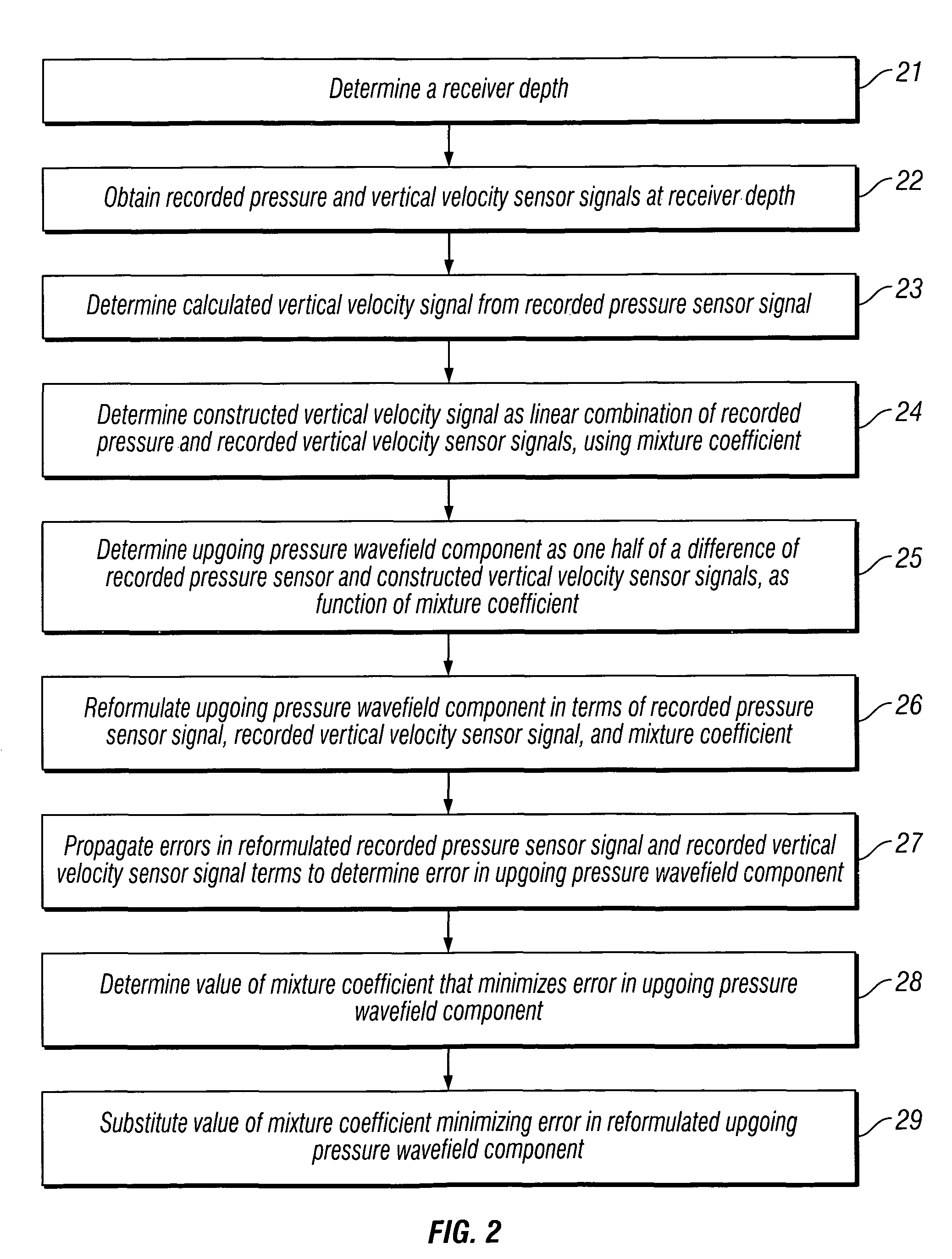Method for attenuating low frequency noise in a dual-sensor seismic streamer
a seismic streamer and low frequency noise technology, applied in chemical methods analysis, instruments, material analysis, etc., can solve the problems of difficult to record data outside a selected bandwidth, difficult to determine whether petroleum deposits are present or not, and different acoustic impedances at the interface, etc., to achieve the effect of attenuating low frequency noise and minimizing errors
- Summary
- Abstract
- Description
- Claims
- Application Information
AI Technical Summary
Benefits of technology
Problems solved by technology
Method used
Image
Examples
first embodiment
[0042]FIG. 1 shows a flowchart illustrating the invention for attenuating low frequency noise in dual-sensor seismic streamer data by combining pressure sensor and vertical velocity sensor signals.
[0043]In box 11, a calculated vertical velocity signal Vzcal is determined from a recorded pressure sensor signal Prec only. The calculated vertical velocity sensor signal Vzcal is preferably calculated in the noisy low frequency portion of a recorded vertical velocity sensor signal Vzrec.
[0044]In box 12, a constructed vertical velocity sensor signal Vzcon is determined as a linear combination of the calculated vertical velocity sensor signal Vzcal in box 11 and the recorded vertical velocity sensor signal Vzrec, using a mixture coefficient α. In a preferred embodiment, the constructed vertical velocity sensor signal Vzcon is determined by a method such as the low frequency replacement process described above in the discussion of U.S. Pat. No. 7,359,283 B2.
[0045]In box 13, an upgoing press...
second embodiment
[0048]FIG. 2 shows a flowchart illustrating the invention for attenuating low frequency noise in dual-sensor seismic streamer data by combining pressure sensor and vertical velocity sensor signals.
[0049]In box 21, a receiver depth zR is determined. The receiver depth zR may be determined by any means known in the art, such as by a depth sensor or a calculation.
[0050]In box 22, a recorded (measured) total pressure sensor signal Prec and a recorded (measured) total vertical velocity sensor signal Vzrec are obtained at the receiver depth determined in box 21. In one embodiment, the recorded pressure sensor signal Prec and the recorded vertical velocity sensor signal Vzrec are obtained from collocated pairs of (groups of) pressure sensors and vertical velocity sensors towed in a marine seismic streamer. Typically, the pressure sensors are hydrophones and the vertical velocity sensors are vertical geophones, but this choice of sensors is not to be considered as a limitation of the invent...
PUM
 Login to View More
Login to View More Abstract
Description
Claims
Application Information
 Login to View More
Login to View More - R&D
- Intellectual Property
- Life Sciences
- Materials
- Tech Scout
- Unparalleled Data Quality
- Higher Quality Content
- 60% Fewer Hallucinations
Browse by: Latest US Patents, China's latest patents, Technical Efficacy Thesaurus, Application Domain, Technology Topic, Popular Technical Reports.
© 2025 PatSnap. All rights reserved.Legal|Privacy policy|Modern Slavery Act Transparency Statement|Sitemap|About US| Contact US: help@patsnap.com



